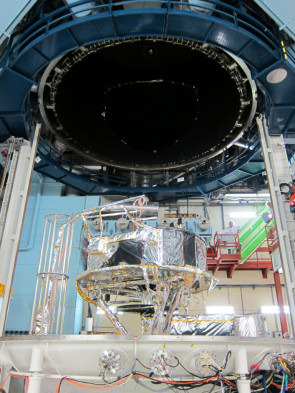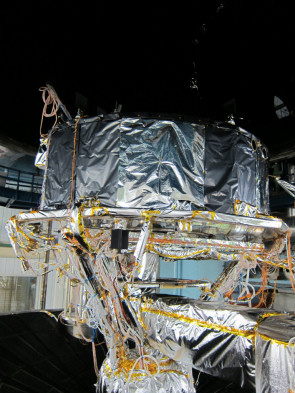#05: Gaia Service Module Thermal Balance/Thermal Vacuum testing completed
10 September 2012
The Protoflight Model of the Gaia Service Module has successfully completed thermal balance and thermal vacuum testing in the SIMLES chamber at Intespace Toulouse. These tests verify the thermal performance of the spacecraft module under space conditions.
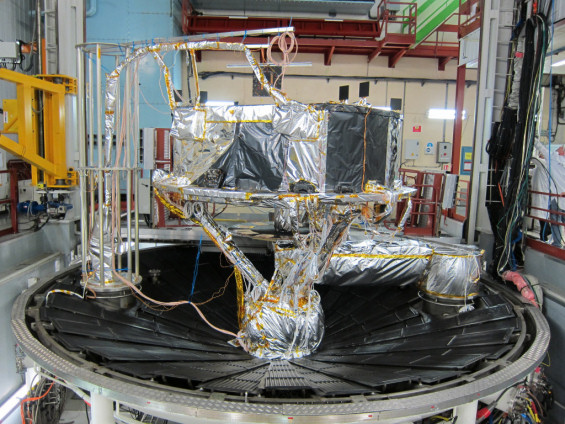 |
|
Gaia Service Module ready for thermal balance/thermal vacuum testing. Credit: Astrium SAS |
Once a spacecraft reaches space, its thermal environment changes dramatically compared to that experienced on Earth. The absence of air means that convection no longer occurs and all heat transfer takes place through conduction and radiation. Those parts of the spacecraft that are pointed towards deep space experience extreme cold - they are radiating towards a thermal sink with a temperature only just above 0 K. Any part of the spacecraft that is illuminated by the Sun experiences solar radiation unattenuated by Earth's atmosphere; the thermal design must ensure that these areas do not attain excessive temperatures and the mission design must keep the rest of the spacecraft in shadow at all times.
Thermal Balance (TB) testing checks the performance of the spacecraft by operating all of its systems in a vacuum and exposed to cooling shrouds, simulating the cold of deep space, until thermal equilibrium is achieved. Thermal Vacuum (TV) testing pushes the spacecraft subsystems to their thermal design limits using test heaters for the hot case, and verifies that they perform correctly.
Gaia will operate in a Lissajous orbit around L2, the second Lagrange point of the Sun-Earth system. This provides a fairly benign thermal environment but the rigorous requirements for the thermal stability of Gaia's payload have driven the thermal design of the spacecraft.
During the cruise to L2 and its operational lifetime, the -X face of Gaia, which is fitted with the solar arrays and main antenna, will point towards the Sun. The deployable sunshield that surrounds this face will protect the rest of the Service Module (SVM) and the Payload Module (PLM) from solar radiation.
Unlike Earth-orbiting satellites, which experience repeated thermal cycling as they move in and out of eclipse, Gaia will operate in a stable thermal environment; this means that the TB/TV testing can be simplified compared to that needed for most other missions.
SIMLES chamber
SIMLES is a space simulation chamber; it is capable of producing conditions that mimic those that a spacecraft will encounter once in space. In addition to recreating the vacuum of space, the chamber reproduces the extreme cold of exposure to deep space by surrounding the item under test with thermal shrouds through which liquid nitrogen is pumped. This achieves a temperature of ~ 100 K - not as cold as deep space, which has a temperature of ~ 2.7 K, but close enough for verification of spacecraft thermal performance and validation of the thermal models used during the design process.
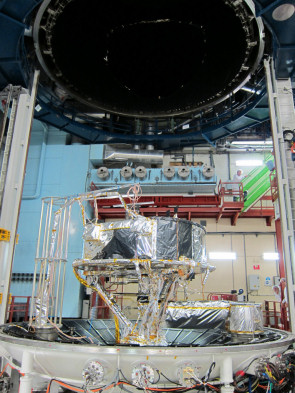 |
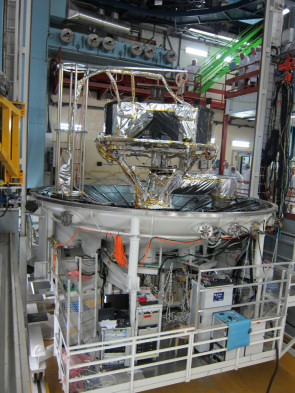 |
|
Gaia Service Module ready for thermal balance/thermal vacuum testing in the SIMLES chamber at Intespace Toulouse. Credit: Astrium SAS |
|
SIMLES is also able to simulate solar illumination, but these capabilities were not used during the Gaia SVM tests. Because of its size (> 10 m across when deployed), the sunshield could not be present during the test. However, the SVM is designed to be in shadow at all times, so no solar illumination was used; dedicated thermal shrouds were used instead.
The main body of the SIMLES chamber is suspended from the structure of the building that houses it. The bottom of the chamber can be lowered away from the main body for the installation of the spacecraft and instrumentation; the Gaia SVM was mounted on a tripod attached to the base of the chamber.
Thermal balance test
With the Gaia SVM mounted on the chamber bottom and all the instrumentation connected, the complete assembly was lifted into place to close the chamber. Vacuum pumping commenced on 23 July 2012 and a pressure of 10-6 mbar (10-4 Pa) was maintained for the duration of the TB/TV test campaign, which lasted until 10 August.
The PLM was not present during these tests; it will begin a separate, two-month long TB/TV test campaign later this year. For the SVM tests, the PLM thermal interface was simulated using thermal shrouds and test heaters. One cycle of TB testing was performed; all results were in accordance with expectations and have confirmed the validity of the thermal models.
Thermal vacuum test
For the TV test, the most critical component was the Phased Array Antenna (PAA). This is the primary means of communication between Gaia and the ground stations that receive science and housekeeping data and transmit commands to the spacecraft. Since the PAA will be permanently illuminated by the Sun, a dedicated thermal shroud was positioned close to it and its performance was verified at the highest operating temperature. The temperatures of the units inside the SVM were controlled by their self-dissipation or with the use of test heaters. External thermal shrouds were employed in critical locations.
One cycle of TV testing was performed. Temperatures inside the SVM varied from -20°C to +70°C; again, all results were as expected. The successful completion of this test campaign marks another step for Gaia in the preparations for launch by the end of next year.
About Gaia
Gaia will create a three-dimensional map of the Milky Way, in the process revealing information about its composition, formation and evolution. The mission will perform positional measurements for about one billion stars in our Galaxy and Local Group with unprecedented precision, together with radial velocity measurements for the brightest 150 million objects. Gaia is scheduled to launch in 2013 for a nominal five-year mission, with a possible one-year extension.
The spacecraft will operate in a Lissajous orbit around the second Lagrange point of the Sun-Earth system (L2). This location in space offers a very stable thermal environment, very high observing efficiency (since the Sun, Earth and Moon are all behind the instrument FoV) and a low radiation environment. Uninterrupted mapping of the sky will take place during the operational mission phase.
The Prime Contractor for Gaia is Astrium SAS, based in Toulouse, France.

